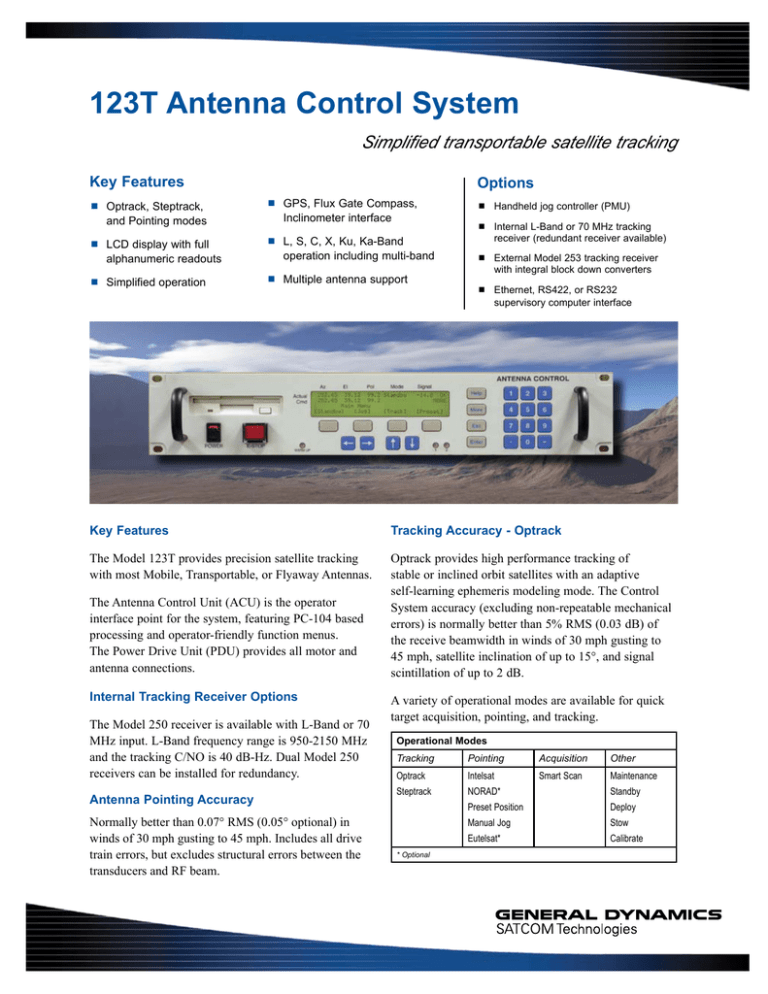
123T Antenna Control System
Simplified transportable satellite tracking
Key Features
Options
Optrack, Steptrack,
and Pointing modes
GPS, Flux Gate Compass,
Inclinometer interface
LCD display with full
alphanumeric readouts
L, S, C, X, Ku, Ka-Band
operation including multi-band
Simplified operation
Multiple antenna support
Handheld jog controller (PMU)
Internal L-Band or 70 MHz tracking
receiver (redundant receiver available)
External Model 253 tracking receiver
with integral block down converters
Ethernet, RS422, or RS232
supervisory computer interface
Key Features
Tracking Accuracy - Optrack
The Model 123T provides precision satellite tracking
with most Mobile, Transportable, or Flyaway Antennas.
Optrack provides high performance tracking of
stable or inclined orbit satellites with an adaptive
self-learning ephemeris modeling mode. The Control
System accuracy (excluding non-repeatable mechanical
errors) is normally better than 5% RMS (0.03 dB) of
the receive beamwidth in winds of 30 mph gusting to
45 mph, satellite inclination of up to 15°, and signal
scintillation of up to 2 dB.
The Antenna Control Unit (ACU) is the operator
interface point for the system, featuring PC-104 based
processing and operator-friendly function menus.
The Power Drive Unit (PDU) provides all motor and
antenna connections.
Internal Tracking Receiver Options
The Model 250 receiver is available with L-Band or 70
MHz input. L-Band frequency range is 950-2150 MHz
and the tracking C/NO is 40 dB-Hz. Dual Model 250
receivers can be installed for redundancy.
Antenna Pointing Accuracy
Normally better than 0.07° RMS (0.05° optional) in
winds of 30 mph gusting to 45 mph. Includes all drive
train errors, but excludes structural errors between the
transducers and RF beam.
A variety of operational modes are available for quick
target acquisition, pointing, and tracking.
Operational Modes
Tracking
Pointing
Acquisition
Other
Optrack
Intelsat
Smart Scan
Maintenance
Steptrack
NORAD*
Standby
Preset Position
Deploy
Manual Jog
Stow
Eutelsat*
Calibrate
* Optional
123T
REMOTE GRAPHICAL USER INTERFACE OPTION
PROVEN PERFORMANCE / EXPERIENCE
Antenna
Band
Testing
240 MVO/DMVO (VRSI)
QUAD
DISA, Intelsat
2.4 SM-LT (VRSI)
QUAD
DISA, Intelsat
8' GMF
X
Engineering
3.8M VRSI (VRSI)
TRI
DISA, Intelsat
2.4M Flyaway (SF-LT) (VRSI)
TRI
DISA, Intelsat
2.4M High Wind (HWT) (VRSI)
QUAD
DISA, Intelsat
4.6M DMVO (VRSI)
TRI
Engineering
2.1M TMS305
X
NATO
LHGXA
X
DISA
QRSA
X
DISA
123T System Diagram
SPECIFICATIONS
CE Certified
Auto Calibrate, Auto Deploy, Auto Stow
Passed Munsen Road Test (shock and vibration)
Single RS 422 Cable for ACU to PDU link
Passed DISA Tracking Stability Test
EL current detect circuit used during stow to
produce known antenna “clamp down” torque
ACU
Size
Weight
Power
2RU rack mount chassis with sides
3.5" H x 19" W x 16.38" D
16 lbs.
Accepts 120/230 VAC, 50/60 Hz, 60W
2RU rack mount chassis with slides
3.5” H x 19” W x 17.13” D
21 lbs.
Accepts 120/230 VAC, 50/60 Hz, 800W Peak
1RU rack mount chassis with slides
1.75” H x 19” W x 17.13” D
18 lbs.
Accepts 120/230 VAC, 50/60 Hz, 800W Peak
PDU
Antenna Interface
AZ/EL/POL DC Motor amplifiers available for 24 -36V motors. Potentiometer or Resolver Position Feedback supported.
EL velocity limit and AZ centered switch inputs available.
Environmental
Temperature
Humidity
Operating
-20° to 60° C
95% Non-Condensing
Storage
-40° to 70° C
95% Non-Condensing
General Dynamics SATCOM Technologies
•
1219 Digital Drive • Richardson, Texas 75081 • Tel: 972-852-5301 • Fax: 972-852-5305 • www.gdsatcom.com
© 2011 General Dynamics. All rights reserved. General Dynamics reserves the right to make changes in its products and specifications at any time and without notice.
GD-SatcomTech 123T October 2011



